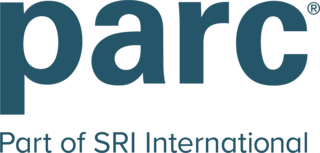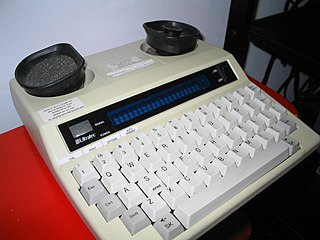Related Research Articles

Douglas Carl Engelbart was an American engineer, inventor, and a pioneer in many aspects of computer science. He is best known for his work on founding the field of human–computer interaction, particularly while at his Augmentation Research Center Lab in SRI International, which resulted in creation of the computer mouse, and the development of hypertext, networked computers, and precursors to graphical user interfaces. These were demonstrated at The Mother of All Demos in 1968. Engelbart's law, the observation that the intrinsic rate of human performance is exponential, is named after him.

SRI Future Concepts Division is a research and development company in Palo Alto, California. It was founded in 1969 by Jacob E. "Jack" Goldman, chief scientist of Xerox Corporation, as a division of Xerox, tasked with creating computer technology-related products and hardware systems.

In telecommunications, an acoustic coupler is an interface device for coupling electrical signals by acoustical means—usually into and out of a telephone.

The Advanced Research Projects Agency Network (ARPANET) was the first wide-area packet-switched network with distributed control and one of the first computer networks to implement the TCP/IP protocol suite. Both technologies became the technical foundation of the Internet. The ARPANET was established by the Advanced Research Projects Agency of the United States Department of Defense.

A telecommunications device for the deaf (TDD) is a teleprinter, an electronic device for text communication over a telephone line, that is designed for use by persons with hearing or speech difficulties. Other names for the device include teletypewriter (TTY), textphone, and minicom.

SRI International (SRI) is an American nonprofit scientific research institute and organization headquartered in Menlo Park, California. The trustees of Stanford University established SRI in 1946 as a center of innovation to support economic development in the region.

A telecommunications relay service, also known as TRS, relay service, or IP-relay, or Web-based relay service, is an operator service that allows people who are deaf, hard of hearing, deafblind, or have a speech disorder to place calls to standard telephone users via a keyboard or assistive device. Originally, relay services were designed to be connected through a TDD, teletypewriter (TTY) or other assistive telephone device. Services gradually have expanded to include almost any real-time text capable technology such as a personal computer, laptop, mobile phone, PDA, and many other devices. The first TTY was invented by deaf scientist Robert Weitbrecht in 1964. The first relay service was established in 1974 by Converse Communications of Connecticut.

Robert Haig Weitbrecht (1920-1983) was an engineer at SRI International and later the spin-off company Weitbrecht Communications who invented a type of a modem.

Mabel Gardiner Hubbard Bell was an American businesswoman, and the daughter of Boston lawyer Gardiner Green Hubbard. She was the wife of Alexander Graham Bell, inventor of the first practical telephone.

The Stanford Dish, known locally as the Dish, is a radio antenna in the Stanford foothills. The 150-foot-diameter (46 m) dish was built in 1961 by the Stanford Research Institute. The cost to construct the antenna was $4.5 million, and was funded by the United States Air Force. In the 1960s the Dish was used to provide information on Soviet radar installations by detecting radio signals bounced off the moon.
The Export–Import Bank of China is a policy bank of China under the State Council. Established in 1994, the bank was chartered to implement the state policies in industry, foreign trade, economy, and foreign aid to other developing countries, and provide policy financial support so as to promote the export of Chinese products and services.
James Carlyle Marsters was a deaf orthodontist in Pasadena, California, who in 1964 helped invent the first teletypewriter device capable of being used with telephone lines. The device made communication by telephone possible for the deaf. Although Robert Weitbrecht did much of the actual design work, Marsters promoted the device's use.
Sophia Kindrick Alcorn was an educator who invented the Tadoma method of communication with people who are deaf and blind. She advocated for the rights of people with disabilities and upon retiring from her long career in teaching, she worked with the American Foundation for the Blind.

China–Sri Lanka relations are the bilateral relations between the People's Republic of China and Democratic Socialist Republic of Sri Lanka. There is a Chinese embassy located in Colombo and a Sri Lankan embassy situated in Beijing. Historical and cultural ties between the two countries extend back hundreds of years.

Weldon Bailey "Hoot" Gibson CBE was an economist and a longtime executive at SRI International, where he worked full-time from 1947 until 1988, and part-time as Senior Director Emeritus until his death. He was closely associated with the organization, and was known as "Mr. SRI".
William Fletcher Talbot was a research chemist and the founding director of SRI International, a position he held from 1946 to 1947.
The Laurent Clerc Award is an annual honor bestowed by Gallaudet University's Alumni Association to recognize a deaf person for "his or her outstanding contributions to society," and specifically to honor their achievements in the interest of deaf people. It is named for Laurent Clerc (1785-1869). It has been given to notable scientists and inventors, such as deaf scientist Robert Weitbrecht, to honor his contributions in developing the teleprinter and an acoustic coupler for the early computer modem. It is awarded by Gallaudet University's Alumni Association through its Laurent Clerc Cultural Fund.

Anderson Jacobson, also known for a time as CXR Anderson Jacobson and today as CXR Networks, is a vendor of communications equipment. Anderson Jacobson was an early manufacturer of acoustic modems and was spun off from SRI International. In the 1970s and 1980s, the company manufactured modems, some intended for consumers. The company was acquired by CXR Telecom in 1988, at which time The Times was following Anderson Jacobson's earnings reports. The flow of new products continued.
References
- ↑ Nielson, Donald (2006). A Heritage of Innovation: SRI's First Half Century. SRI International. pp. F1-4. ISBN 978-0-9745208-1-0.
- ↑ Lang, Harry G (2000). A phone of our own: the deaf insurrection against Ma Bell . Gallaudet University Press. p. 96. ISBN 1-56368-090-4.
Weitbrecht Communications stanford SRI.